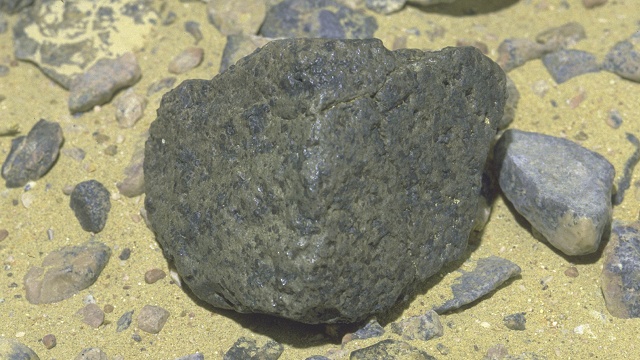
After almost 50 years, we’re getting rather familiar with Mars. We have spacecraft images dating back to 1965 and chemical evidence from lander missions beginning in the 1970s. For years, orbiters have been recording the surface of Mars in spy-satellite detail. And Mars has sent actual rock specimens our way in the form of meteorites. A paper in the March 7 issue of Science argues that most of the Mars rocks in our collections come from one place, a big young crater named Mojave.
Rocks from Mars are a rare component of the hundreds of thousands of meteorites we’ve collected. They’re flung into space when cosmic collisions on Mars blast craters in its rocky crust, then they drift around the solar system for a while until Earth’s gravity draws them close enough to fall. We have about 150 specimens in our hands. Nearly all of them are the same rock type, given the name shergottite after the meteorite named Shergotty, which fell near Sherghati, India, in 1865. It’s a heavy, magnesium-rich mix of the minerals olivine, pyroxene and feldspar that is similar to the so-called ultramafic rocks of our own oceanic crust.
The Science paper reports efforts to trace shergottites and other Martian meteorites to their source. The research team, consisting of Stephanie Werner (University of Oslo), Anouck Ody (Lyon University) and François Poulet (Paris University Sud), first presented their work at the Lunar and Planetary Science Conference last year in Texas, but this paper marks its formal publication.
The authors had several facts at their disposal. The Martian stones consist of a well-known mix of minerals that can be checked against satellite observations of the Martian surface. They have a controversially wide range of age determinations, with most being more than 4 billion years old and a few as young as 150 million years old. And they have been exposed to cosmic rays for as little as 1 million years. This represents the time they were floating in space before falling to Earth.
Werner’s team then made a new search for the youngest craters on Mars. These are best known from their fresh appearance and the presence of dust deposits that form a star-shaped pattern. The rays don’t show up well in ordinary light, but thermal images taken at night display them well. A prevous study found eight of these rayed craters, most of them only a few kilometers across. Only one of that group, Zunil, is large enough (about 10 km across) that the energy spent in forming it could have launched rocks free of Mars’s gravity.
